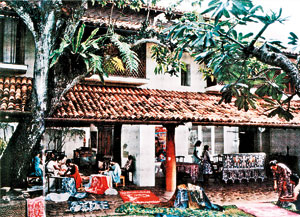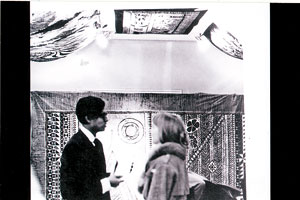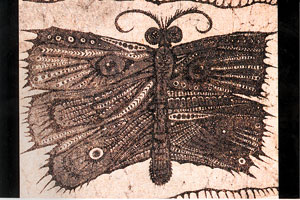When Ena’s batiks went to Copenhagen
View(s):Ismeth Raheem looks back at an exhibition nearly 50 years ago
There is something remarkable in the journey of an enterprise from a one-woman effort at experimentation with a small labour force that began operations in Colombo, then moved to the city’s suburbs in Rajagiriya, then Bolawalana (near Negombo) and finally found its home as a cooperative in Aluvihare (Matale). After years of itinerant life, it was here that Ena de Silva held court when she moved into a residence built by her father Sir Richard Aluvihare and remodelled in her own eccentric style.

Ena de Silva and Laki Senanayake working at the first workshop at her courtyard residence designed by architect Geoffrey Bawa at No.5, Alfred Place, Colombo 3 (National Geographic Magazine, April 1966)
One of the first to use the wax-resist dying technique of transferring images in colour on to textiles in recent times was the pioneer batik craftsperson Soma Udabage, who revived the method after a short study tour in Indonesia. Ena made her foray into this revived medium, which was still in a stage of infancy, sometime around the early 1960s. During this early phase all the work involved from destarching the cloth to setting out the design, waxing, dying, and removal of the wax for a second colour by boiling off the wax, repeating this process several times over, and ultimately fixing the final image was all carried out in her residence at No.5, Alfred Place,Colombo. She shared this both as a family home as well as a workshop, with her husband, senior police officer Osmund de Silva who went on to become the second Sri Lankan Inspector General of Police and her two hugely talented children Anil and Kusum. From the outset, their design drawings were extensively incorporated in several of the batik wall hangings.
Ena’s passion for learning new techniques and imparting her knowledge to a large work force of semi-skilled labour largely women from a rural background with very little artistic training is cause for some wonder and makes her contribution in many ways noteworthy. Ena travelled widely in India (Rajasthan), China and Japan and absorbed many craft innovations; her productions reflect as many cultural shifts.
Her persistent pioneering spirit in design and experiments in various indigenous materials such as wood, brass, paper, and textile is another; and the consistency, which her designs were aesthetically right, is simply spellbinding and merits more research and attention.
In numerous dialogues with her both in her home in Colombo and in Aluvihare where she moved to in the 1980s, she made clear the influence of multiple friends who supported and even worked with her. It was on the insistence of Dr. Andreas Nell, an antiquarian and man of taste and scholarly bent that she obtained a copy of Ananda Coomaraswamy’s influential magnum opus –Medieval Sinhalese Art (1908). It was one of her first acquisitions in the 1950s at a time when she had few resources from her husband’s meagre earnings as a senior police officer.

Opening night of the Ena de Silva Fabric exhibition at the Ceylon Tea Centre, Copenhagen. December 1967 -Ismeth Raheem in the foreground with a Danish guest
At the time of acquisition the book was quite expensive as a limited edition publication of 425 copies especially handprinted by the author in William Morris’s own Essex House Press in the Norman chapel at Broad Campden, Gloucestershire, England.About this time Ena also met Mrs. Daisy Rodrigo who played a vital role in her quest to acquire the skills necessary in the various craft techniques in textile printing.
She discovered her latent talent to produce exciting designs for which she was admired and renowned later in a career that spanned almost half a century.
She set herself up to produce batiks in her residence, exquisitely designed in 1960/2 by Geoffrey Bawa who was then starting his architectural career. Ena de Silva was fortunate to team up with Laki Senanayake, an artist and architectural designer working at Edwards Reid and Begg under the tutelage of Geoffrey Bawa. Laki and Ena, a finely tuned team continued to experiment with the various techniques and tools for printing on textiles. Following this the firm, Ena de Silva Fabric was founded with Ena, Laki and Reggie Siriwardene as directors.
Meanwhile, a serendipitous association with Laki in 1960 led to my helping them both at the workshop they had set up in a bungalow in Alfred House Gardens near her residence. Under Laki’s watchful eye, I managed to pick up the rudiments of dyeing and waxing and slowly learned the skills involved in batik. Working as an unpaid assistant at the dyeing workshop led to a lifetime association and friendship with Ena.
The 1960s were turbulent years for artists, architects and craftspersons.
The draconian laws limiting imports to only essential items made it a hard time for any one who needed equipment and materials needed for such specialised work. One had to make do, and adapt with indigenous raw materials; there was very little as far as fine quality dyes, and related materials for printing of textiles were concerned.

Butterfly design four-coloured batik by Laki Senanayake at the exhibition
By October 1966, when I was offered a scholarship by the Danish Government to continue my architectural studies at the Royal Danish Academy, Copenhagen an opportunity presented itself. It was evident that one had to assist Ena de Silva’s firm in their valuable contribution to textile dyeing and weaving. As soon as I settled down to commence my architectural education, it dawned on me that an exhibition of batiks of the Ena de Silva Fabrics would greatly assist the struggling firm. In addition to finding a market in Europe, the sale also helped to provide foreign exchange to obtain scarce dyes and materials for the firm’s activities.
In the first week of December 1967, an exhibition of Ena de Silva Fabric was opened at the fashionable Ceylon Tea Centre, Walking Street (49, Vimmelskaftet), Copenhagen. Not only was it well attended by the public; some of the leading members of the architectural staff of the Academy were guests at the opening. The exhibition showcased several of Laki’s original designs.
The leading Danish newspaper -Berlingske Tidende (December 4, 1967) published a supportive review of the firm’s work.
This exhibition was probably the only sales the firm had in Europe till the collaborative effort with Geoffrey Bawa in Germany in 2005.
(This essay is in appreciation of the contribution made by Ena de Silva (October 23, 1922- October 30, 2015) to the development of the arts and crafts of this country over a period over half a century. It focuses on her work in batik printing in the 1960s, which then blossomed into other areas as her career, advanced)


